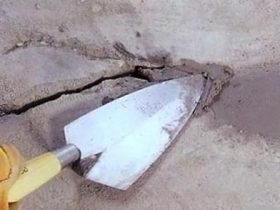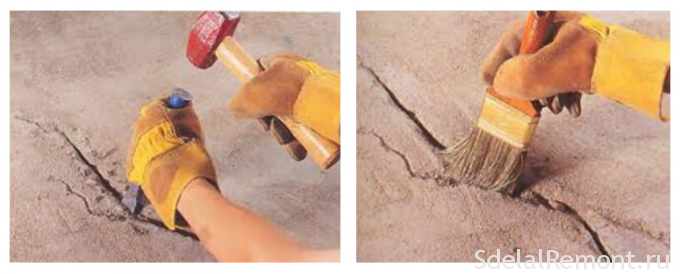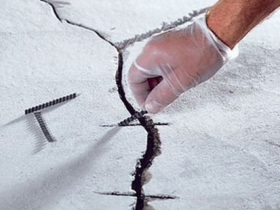When choosing a self-leveling screed way, the consumer is guided by its reliability and durability. but, often after drying, floor cracks, potholes and other defects. This is due to a violation of work technology, as well as failure to comply with temperature control. The problem can be eliminated by repair, but it is necessary to understand, where the cracks.
The main causes of defects
Most often cracks appear there, where a large cement concentration occurs. This is due to the following factors:
- poor quality cement mixture with impaired production technology;
- failure to comply with the proportions of components of the screed;
- violation of the temperature at the floor pouring and drying;
- lack of expansion joints;
- human factor.
Let us consider each of these reasons.
- The quality of the cement mixture depends, what components have been used in its manufacture. If the manufacturer saves on the part of, then expect good results do not have to. When choosing a self-leveling floor, pay attention to consumer feedback and to those marks, which have long established themselves on the positive side.
- Esslin involved in self-leveling floor Component proportions are not met, defects appear in any case. If water is poured into a solution of, the drying will occur unevenly, thus will crack. A large amount of water reduces the strength of the coating, and the appearance on the surface portions of unconsolidated. To avoid problems, strictly follow the instructions on the pack, and add just enough water, as specified by the manufacturer.
Besides, it is not necessary to mix the solution manually. For this purpose there is a special attachment - whisk for drills, via which the mixture was dissolved uniformly, and not form lumps dry matter. there is 8 ways of exhibiting beacons under the floor fill.
- Temperature - the main factor in the formation of floor screed. She was also accompanied by the required humidity of the room for even drying. If, during this process, the differential data rates - may have defects. At low humidity, water evaporates much faster, which decreases the surface strength, High humidity slows the process and increases the drying time, due, what delayed the timing of laying topcoat.
High temperatures will promote rapid set floor hardness and result in the formation of cracks, and the lowest temperature - will prolong the drying surface.
Besides, due to drafts and rapid change of temperature and humidity, screed dries unevenly: top layer dries quickly lower, that does not match the right technology.
- When pouring the floor should not forget about the compensation of wall joints. These seams will protect screed from the walls of the deformation load. If the room there are stairs and columns - they also need to pave the elastic material before pouring the floor, this will prevent cracking.
- No one is immune from unskilled workers during repairs. choosing masters, note that they have the professional tools and proper equipment to perform the work on the floor arrangement.
In addition to the main causes of cracking, there are those, which are less common:
- the absence of a vapor barrier;
- Forced drying floor;
- the absence of reinforcement;
- properly chosen layer thickness;
- Communications under the floor.
Avoiding these items will make the floor flat and not be afraid of cracking. Common cause of sex is a violation of bursting dry screed technology.
Floor preparation for repair
If the cracks are still formed, should not give up, because you can restore the floor. Before working, you must perform some training:
- Determine, for whatever reason, there was a crack. This will be a decisive factor when choosing a method of embedding the defect. If we work on the floor doing the master device, should find out whether there are expansion joints Wall St, as well as the manner in which filling the floor has been executed.

- Cracking due to the absence of the expansion joint between rooms, says, that it is necessary to lay, and only then begin repairs.
- When the cracks resemble small pieces, scattered throughout the room, to repair their used epoxy adhesive, solution which is poured into the defective areas on the surface.
- Highlight those areas, that are cracked, and determine the degree of damage. In addition to visible faults, can also be hidden cracks. They can be found, tapping a wooden mallet on the screed - will be issued a distinctive ringing sound.
- If the calculation of the total area, needs repairs, will be more 30 % surface, it is recommended to completely remove the coating and produce pouring a new floor.
How to patch up small cracks?
Small cracks in the screed are eliminated easier, than larger. To do this, use a chisel, with which to deepen the crack on 15 mm, as well as to expand its. Convenient to use the grinder with diamond blade. The next step will be cleaning the cracks and areas around it. This can be done with the help of the construction of the vacuum cleaner. The surface should not remain the slightest particle.

Then crack primed. After treatment with such a composition, increases adhesion and crack solution.
Convenient and practical to use a tile adhesive, it has a good performance.
Dried slot is filled with a solution for floor screed, and after drying the repaired area sanded. Choosing mixtures and compositions for restoring, pay attention to their quality. If it is applied to the example tile adhesive with low strength, the cause of the cracks will not go away. Moreover, may be new defects.
What to do with large cracks?
Deep and large cracks also be repaired. similar procedure, but still it has the distinction. With grinders, crack deepens and widens at least 50 mm. If a defect is detected on the side surface, then it stuffed grooves. After that, an extended crack thoroughly cleaned of dust and debris.
The entire length of the crack punched grooves perpendicular to it. Their length should be 15 cm, and depth to 20 mm, wherein the distance between them is 30 mm. using a vacuum cleaner, the surface is cleaned again. The next step is processing portion primer mixture.
Self sealing cracks process occurs using an adhesive cement or cement mortar for floor screeds, wherein one of the components must be sand.
Filling defect occurs in two ways. The first stage filled with punched slots. They set the vertical bracket, after which the surface should dry. The second stage consists of pouring most cracks and its filling same brackets, and complete drying layer.
If the crack is too deep, repair is carried out in three stages. When the coating has dried, all parts are sanded to a smooth state. Repair of this method eliminates the formation of new cracks due to the reinforcement of the old defects metal straps.
Repair of potholes, cracks and holes in the screed - the procedure is costly and time consuming. So the best option to avoid problems would be compliance with all the rules in the floor casting.












